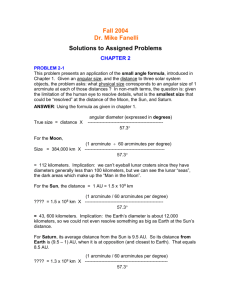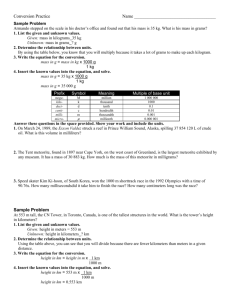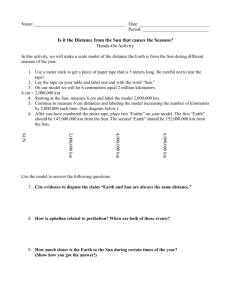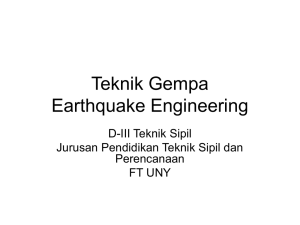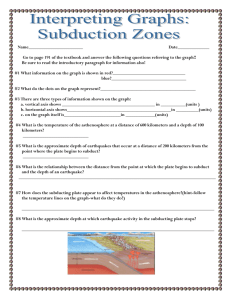Physics 1060 – Stars, Galaxies, and the Universe
advertisement
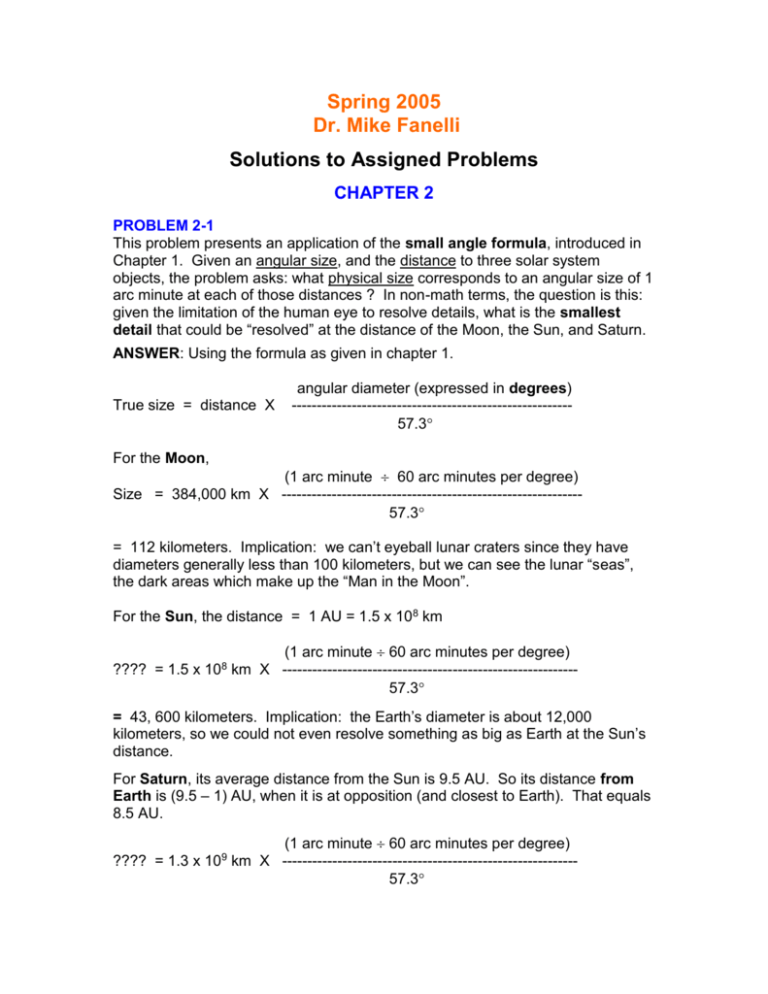
Spring 2005 Dr. Mike Fanelli Solutions to Assigned Problems CHAPTER 2 PROBLEM 2-1 This problem presents an application of the small angle formula, introduced in Chapter 1. Given an angular size, and the distance to three solar system objects, the problem asks: what physical size corresponds to an angular size of 1 arc minute at each of those distances ? In non-math terms, the question is this: given the limitation of the human eye to resolve details, what is the smallest detail that could be “resolved” at the distance of the Moon, the Sun, and Saturn. ANSWER: Using the formula as given in chapter 1. True size = distance X angular diameter (expressed in degrees) -------------------------------------------------------57.3 For the Moon, (1 arc minute 60 arc minutes per degree) Size = 384,000 km X -----------------------------------------------------------57.3 = 112 kilometers. Implication: we can’t eyeball lunar craters since they have diameters generally less than 100 kilometers, but we can see the lunar “seas”, the dark areas which make up the “Man in the Moon”. For the Sun, the distance = 1 AU = 1.5 x 108 km (1 arc minute 60 arc minutes per degree) ???? = 1.5 x 108 km X ----------------------------------------------------------57.3 = 43, 600 kilometers. Implication: the Earth’s diameter is about 12,000 kilometers, so we could not even resolve something as big as Earth at the Sun’s distance. For Saturn, its average distance from the Sun is 9.5 AU. So its distance from Earth is (9.5 – 1) AU, when it is at opposition (and closest to Earth). That equals 8.5 AU. (1 arc minute 60 arc minutes per degree) ???? = 1.3 x 109 km X ----------------------------------------------------------57.3 = 372, 000 kilometers. Note that this value is larger than the planet’s diameter, which is why we can’t see a disk when we look at Saturn. PROBLEM 2-8: How long would it take a radar signal to complete a round trip between Earth and Mars when the two planets are 0.7 AU apart ? ANSWER: This problem deals with the speed of a radar signal, which, like light waves, travels at 300,000 kilometers per second. You are asked to determine a time interval. The problem is set up in exactly the same manner as if you were estimating your travel time for an airline trip. What is the distance traveled ? How fast are you going ? Distance = 0.7 AU (Earth-Mars distance) 150,000,000 kilometers per AU 2 (the signal travels to Mars and back, a roundtrip) = 2.1 x 108 kilometers Time = distance divided by the rate of travel = 2.1 x 108 kilometers 300,000 km per sec. = 700 seconds = 11.7 minutes PROBLEM 2-14: Use Newton’s Law of gravity to calculate the force of gravity between you and Earth, converting your answer to pounds. What do you normally call this force ? ANSWER: The force of gravity is expressed: F(grav) = G (m M) r2 The task here is to assign the correct value to each variable in this expression, then evaluate the expression. G is the “constant of gravitation”; its value is given in the text: G = 6.67 x 10-11 newtons meter2 / kg2 “Big” M is the mass of Earth = 6 x 1024 kg. “r” is the separation between you and the center of the Earth, otherwise known as the radius of the Earth. r = 6400 kilometers. To evaluate the expression, you need to assign a value for little “m”, which is YOUR mass. I’ve used 70 kilograms for an “average” student mass. You must also be sure that similar units are expressed the same way. Here you need to convert the Earth’s radius, which is given in kilometers to meters, because both “G” and newtons are expressed in meters. Inserting these values in the equation, F(grav) = 684 newtons. If 1 lb = 4.45 newtons then 0.225 lbs = 1 newton (dividing each side by 4.45). Therefore, 684 newtons x 0.225 lbs per newton = 153 lbs. 153 lbs = the force of gravity on this person, which is normally called a person’s weight.

